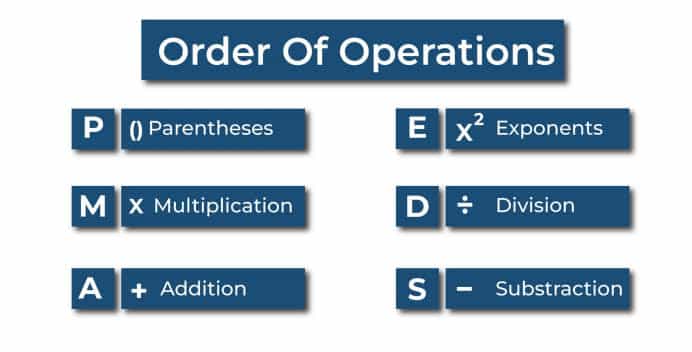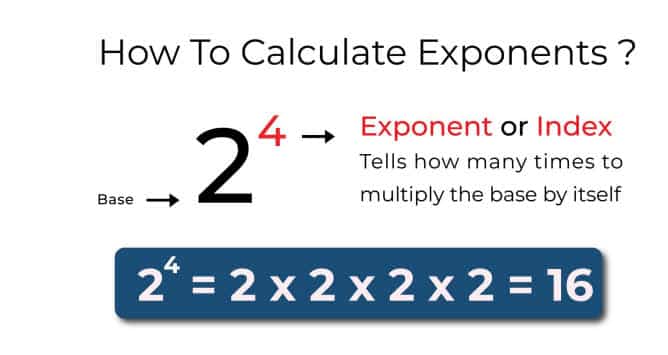
Order of Operations
Third Grade Tutoring – tried and trusted way to supplement your child’s academic performance.
The order of operations is the set of rules that defines the order in which calculations must be carried out in a mathematical expression. The order of operations is important because it determines how calculations are performed, which can affect the result.
The standard order of operations is as follows:
- Perform any calculations inside parentheses or brackets first.
- Perform any calculations involving exponents or radicals.
- Perform any multiplications and divisions, working from left to right.
- Perform any additions and subtractions, working from left to right.
Using parentheses to specify the order in which calculations should be performed is a good idea, especially when working with more complex expressions.

The acronym PEMDAS, which stands for Parentheses, Exponents, Multiplication and Division, Addition and Subtraction, is often used to help remember the order of operations. The acronym PEMDAS is also used and is the same as PEMDAS, just with the M and D switched. It is essential to use the correct order of operations when evaluating mathematical expressions to ensure that the correct result is obtained.
Parentheses
In the order of operations, calculations inside parentheses or brackets are performed first. This is because parentheses and brackets are used to group calculations that should be done before any other functions in the expression.
For example, consider the following expression:

Without any parentheses, it is not clear what should be calculated first. Should the multiplication be done before the addition or the other way around? To specify the order in which the calculations should be performed, we can use parentheses:

In this case, the expression inside the parentheses, 4 + 3, is calculated first, giving a result of 7. Then the multiplication is performed, showing a final result of 35 – 2, or 33.
Using parentheses correctly in an expression is essential to ensure that the intended order of operations is followed and the correct result is obtained.
Another example to show that groupings inside should be solved first.

Step 1: In this case, the expression inside the parentheses (32 ÷ 4) should be calculated first. So it will be 8.
Step 2: Now the expression inside the square parentheses [8 + 3] should be solved. So, it will be 11.
Step 3: Then the multiplication is performed, showing a final result of 11 × 2 = 22.
Exponents
In the order of operations, calculations involving exponents, also known as powers or indices, are performed before any multiplications or divisions. This is because exponents indicate the number of times a number should be multiplied by itself, and these calculations should be done before any other operations (except parentheses) in the expression.
An exponent is a small number written above and to the right of another number, called the base. The exponent tells you how many times to multiply the base by itself. For example, the base 4 and exponent 3 can be written like this: 4^3. This means to multiply 4 by itself 3 times, or 4*4*4. The result is 64.

For example, consider the following expression:
2 + 3 * 4^2
In this case, the exponent, 4^2, indicates that 4 should be multiplied by itself 2 times, or 4*4, which gives a result of 16. The exponent calculation is done before the multiplication, so the outcome of the expression is 2 + 3 * 16, or 2 + 48, or 50.
Multiplication and Division
In the order of operations, multiplication and division are performed before addition and subtraction. This is because multiplications and divisions are considered equal priorities and should be performed before any additions or subtractions.
For example, consider the following expression:
2 + 4 * 3 – 6 / 2
In this case, the multiplication and division should be performed before the additions and subtractions. First, the multiplication is done: 4 * 3 = 12. Then the division is done: 6 / 2 = 3. Finally, the additions and subtractions are made: 2 + 12 – 3 = 11.
Here is another example:
5 – 4 / 2 + 8 * 3
In this case, the division and multiplication should be done first: 4 / 2 = 2 and 8 * 3 = 24. Then the additions and subtractions are done: 5 – 2 + 24 = 27.
Addition and Subtraction
In the order of operations, additions and subtractions are the final calculations that should be performed. This is because they are considered equal priority and should be performed after all other calculations have been completed.
For example, consider the following expression:
2 + 4 * 3 – 6 / 2
In this case, multiplication and division should be performed before the additions and subtractions. First, the expansion is done: 4 * 3 = 12. Then the division is done: 6 / 2 = 3. Finally, the additions and subtractions are made: 2 + 12 – 3 = 11.
Here is another example:
5 – 4 / 2 + 8 * 3
In this case, the division and multiplication should be done first: 4 / 2 = 2 and 8 * 3 = 24. Then the additions and subtractions are done: 5 – 2 + 24 = 27.
Example 1:
Solve: 2 + 6 × (4 + 5) ÷ 3 – 5 using PEMDAS.
Solution:
Step 1 – Parentheses : 2+6 × (4 + 5) ÷ 3 – 5 = 2 + 6 × 9 ÷ 3 – 5
Step 2 – Multiplication: 2 + 6 × 9 ÷ 3 – 5 = 2 + 54 ÷ 3 – 5
Step 3 – Division: 2 + 54 ÷ 3 – 5 = 2 + 18 – 5
Step 4 – Addition: 2 + 18 – 5 = 20 – 5
Step 5 – Subtraction: 20 – 5 = 15
Practice Questions:
- Solve 100 ÷ (6 + 7 × 2) – 5 using PEMDAS.
- Solve 600 ÷ (44 + 14 × 4) – 5 using PEMDAS.
FAQs
1. What does PEMDAS stand for?
PEMDAS stands for Parentheses, Exponents, Multiplication, and Division, and Addition and Subtraction. This acronym is used to help remember the order of operations in mathematics.
2. What is the order of operations in PEMDAS?
The order of operations in PEMDAS is as follows: Parentheses first, then Exponents, then Multiplication and Division (performed left to right), and finally Addition and Subtraction (performed left to right).
3. Why is the order of operations important?
The order of operations is important because it determines the order in which calculations are performed, which can affect the result. It is essential to use the correct order of operations to ensure that the correct result is obtained.
4. What is the meaning of the acronym PEMDAS?
The acronym PEMDAS stands for Parentheses, Exponents, Multiplication and Division, and Addition and Subtraction. These terms represent the order in which calculations should be performed in a mathematical expression.
5. What if I am not happy with kindergarten tutors?
You can reach out to us any time: +1 269 763 4602/5024. Our representatives will be happy to resolve issues to better your learning experience. We encourage students and parents to contact us if their child faces any problems. We’ll work to make this work for you. However, if the problem persists, don’t worry; our 30-day money-back guarantee guards your money.
6. How do I sign up for kindergarten tutoring for my child?
You can sign up with your name and email address (no credit card or purchase obligation required). Additionally, you can schedule a free session with our Kindergarten online tutors. For Sign up: https://www.etutorworld.com/free-trial.html
IN THE NEWS

Our mission is to provide high quality online tutoring services, using state of the art Internet technology, to school students worldwide.
Online test prep and practice
SCAT
CogAT
SSAT
ISEE
PSAT
SAT
ACT
AP Exam
Science Tutoring
Physics Tutoring
Chemistry Tutoring
Biology Tutoring
Math Tutoring
Pre-Algebra Tutoring
Algebra Tutoring
Pre Calculus Tutoring
Calculus Tutoring
Geometry Tutoring
Trigonometry Tutoring
Statistics Tutoring
Quick links
Free Worksheets
Fact sheet
Sales Partner Opportunities
Parents
Passive Fundraising
Virtual Fundraising
Our Expert Tutors
Safe and Secure Tutoring
Interactive Online Tutoring
After School Tutoring
Elementary School Tutoring
Middle School Tutoring
High School Tutoring
Home Work Help
Math Tutors New York City
Press
©2022 eTutorWorld Terms of use Privacy Policy Site by Little Red Bird
©2022 eTutorWorld
Terms of use
Privacy Policy
Site by Little Red Bird






